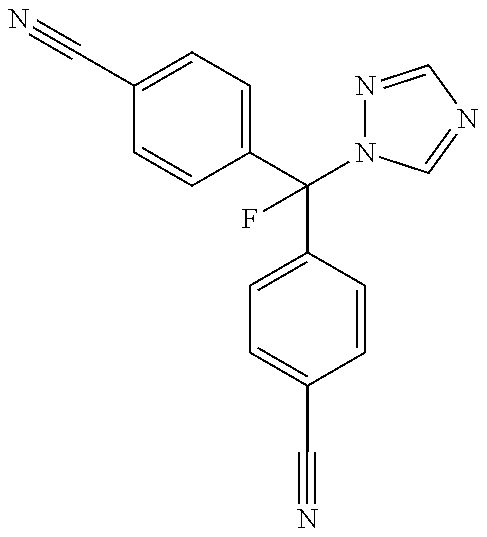Use of an aromatase inhibitor for the treatment of hypogonadism and related diseases
an aromatase inhibitor and hypogonadism technology, applied in the direction of drug composition, metabolic syndrome, cardiovascular disorder, etc., can solve the problems of polycythemia (erythrocytosis), limited current treatment options for testosterone deficiency, and increased risk of cardiovascular disease, so as to achieve the effect of increasing testosterone levels
- Summary
- Abstract
- Description
- Claims
- Application Information
AI Technical Summary
Benefits of technology
Problems solved by technology
Method used
Image
Examples
example 1
Preparation of 4,4′-[fluoro-(1-H-1,2,4-triazol-1-yl)methylene]bisbenzonitrile
[0174]The following example describes a method for the synthesis of 4,4′-[fluoro-(1-H-1,2,4-triazol-1-yl)methylene]bisbenzonitrile (also known as 4-[α-4-Cyanophenyl)-α-fluoro-1-1,2,4-triazolyl)-methyl]-benzonitrile or CGP47645) as disclosed within Lang et al., U.S. Pat. No. 5,637,605:
[0175]A solution of 0.8 mmol of potassium hexamethyldisilazane in 1.6 ml of toluene is diluted with 5 ml of THF and, after cooling to −78° C., a solution of 190 mg of 4-[α-(4-cyanophenyl)-1-(1,2,4-triazolyl)methyl]-benzonitrile (see EP-A-236 940, Ex. 20a) in 3 ml of THF is added thereto. After stirring for 1 hour at the same temperature, there are added dropwise to the dark-red solution 301 mg of N-fluoro-dimethylsaccharinsultam in 3 ml of THF. After a further 1.5 hours at −78° C., the reaction mixture is heated to room temperature within 1 hour and poured onto a saturated solution of ammonium chloride in water and then extract...
example 2
Formulations of 4,4′-[fluoro-(1-H-1,2,4-triazol-1-yl)methylene]bisbenzonitrile (CGP47645)
[0180]4,4′-[Fluoro-(1-H-1,2,4-triazol-1-yl)methylene]bisbenzonitrile (CGP47645) is provided in the form of hard gelatine capsules representing an immediate release dosage form for oral administration. The dosage form is a hard gelatine capsule containing a white to yellowish powder in a pink opaque capsule, size 1 or 3. Three strengths are provided, containing 0.1 mg, 0.5 mg or 1.0 mg CGP47645 per hard gelatine capsule. The excipients used to prepare the hard gelatine capsules are lactose, microcrystalline cellulose, corn (maize) starch, sodium starch glycolate, magnesium stearate, colloidal silicon dioxide. All the excipients comply with the requirements of the applicable compendial monographs (Ph.Eur., NF). The hard gelatine capsules are packaged in HDPE bottles with aluminum induction seal equipped with child-resistant screw-cap closures.
[0181]CGP47645 containing hard gelatine capsules are pr...
example 3
Single ascending dose study of 4,4′-[Fluoro-(1-H-1,2,4-triazol-1-yl)methylene]bisbenzonitrile (CGP47645)
[0184]This was a randomized, double-blind, placebo- and active-controlled single ascending dose study in pre- and post-menopausal women to assess the safety and tolerability, PK and PD effects of single doses of 4,4′-[Fluoro-(1-H-1,2,4-triazol-1-yl)methylene]bisbenzonitrile (CGP47645). There were 8 cohorts of 8 post-menopausal subjects randomized 6:2, CGP47645:placebo, who received single doses of CGP47645 beginning at the dose of 0.01 mg and carried through 20 mg, which reached the limit of the toxicology exposure coverage. Patients received either 0.1 mg, 1 mg, and 10 mg drug substance containing hard gelatin capsules or appropriate matching placebo capsules. For the lowest two dosing cohorts, 0.1 mg drug containing capsules were used for reconstituting the CGP47645 oral solutions for dosing the 0.01 and 0.03 dosing strength (Cohort 1 and 2).
[0185]A minimal toxic dose (MTD) was ...
PUM
| Property | Measurement | Unit |
|---|---|---|
| concentration | aaaaa | aaaaa |
| concentration | aaaaa | aaaaa |
| time | aaaaa | aaaaa |
Abstract
Description
Claims
Application Information
 Login to View More
Login to View More - R&D
- Intellectual Property
- Life Sciences
- Materials
- Tech Scout
- Unparalleled Data Quality
- Higher Quality Content
- 60% Fewer Hallucinations
Browse by: Latest US Patents, China's latest patents, Technical Efficacy Thesaurus, Application Domain, Technology Topic, Popular Technical Reports.
© 2025 PatSnap. All rights reserved.Legal|Privacy policy|Modern Slavery Act Transparency Statement|Sitemap|About US| Contact US: help@patsnap.com

